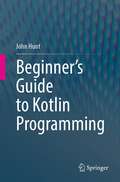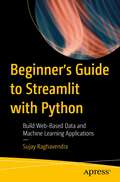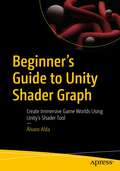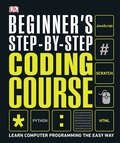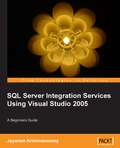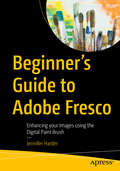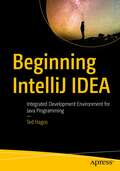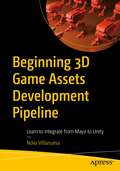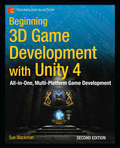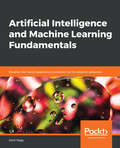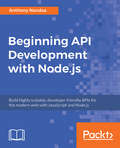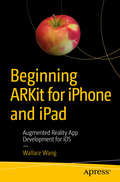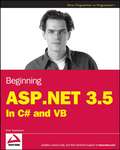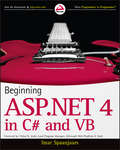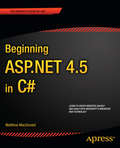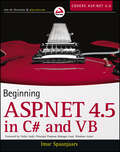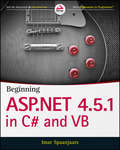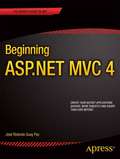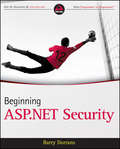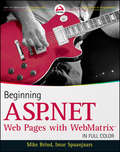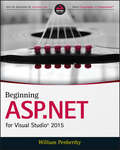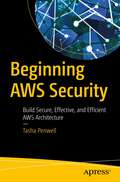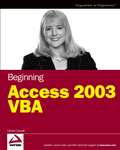- Table View
- List View
Beginner's Guide to Kotlin Programming
by John HuntThis textbook assumes very little knowledge of programming so whether you have dabbled with a little JavaScript, played with a bit of Python, written Java or have virtually no programming experience at all you will find that it is for you.The first part of the book introduces Kotlin program structures as well as conditional flow of control features such as if and when expressions as well as iteration loops such as for, while and do-while. Subsequent chapters explain how functions are implemented in Kotlin and introduce concepts from functional programming such as higher order functions and curried functions.The second part focusses on object oriented programming techniques, these include classes, inheritance, abstraction and interfaces. The third part presents container data types such as Arrays, and collections including Lists, Sets and Maps and the fourth part considers concurrency and parallelism using Kotlin coroutines. The book concludes with an introduction to Android mobile application development using Kotlin.Clear steps are provided explaining how to set up your environment and get started writing your own Kotlin programs.An important aspect of the book is teaching by example and there are many examples presented throughout the chapters. These examples are supported by a public GitHub repository that provides complete working code as well as sample solutions to the chapter exercises. This helps illustrate how to write well structured, clear, idiomatic Kotlin to build real applications.
Beginner's Guide to Streamlit with Python: Build Web-Based Data and Machine Learning Applications
by Sujay RaghavendraThis book will teach you the basics of Streamlit, a Python-based application framework used to build interactive dashboards and machine learning web apps. Streamlit reduces development time for web-based application prototypes of data and machine learning models. As you’ll see, Streamlit helps develop data-enhanced analytics, build dynamic user experiences, and showcases data for data science and machine learning models. Beginner's Guide to Streamlit with Python begins with the basics of Streamlit by demonstrating how to build a basic application and advances to visualization techniques and their features. Next, it covers the various aspects of a typical Streamlit web application, and explains how to manage flow control and status elements. You’ll also explore performance optimization techniques necessary for data modules in a Streamlit application. Following this, you’ll see how to deploy Streamlit applications on various platforms. The book concludes with a few prototype natural language processing apps with computer vision implemented using Streamlit. After reading this book, you will understand the concepts, functionalities, and performance of Streamlit, and be able to develop dynamic Streamlit web-based data and machine learning applications of your own. What You Will Learn How to start developing web applications using Streamlit What are Streamlit's components Media elements in Streamlit How to visualize data using various interactive and dynamic Python librariesHow to implement models in Streamlit web applicationsWho This Book Is ForProfessionals working in data science and machine learning domains who want to showcase and deploy their work in a web application with no prior knowledge of web development.
Beginner's Guide to Unity Shader Graph: Create Immersive Game Worlds Using Unity’s Shader Tool
by Álvaro AldaDiscover how shaders can enhance your game and mesmerize players by making graphic gameplay elements more realistic and attractive. This book provides easy-to-follow recipes that will show you how to leverage the Unity Shader Graph to create more immersive, enjoyable games. Author Álvaro Alda takes you through each effect step by step, so that you gain a foundational understanding of how they are created using the Shader Graph tool. Practical projects help you put what you’re learning into context, from simple effects like 3D scan lines to more complicated effects such as black holes, bubble particles, water, and even interactive snow. Twelve different effects are demonstrated, to cover almost everything related to shader graph. On completing this book, you will have a thorough understanding of the Shader Graph tool and samples to replicate and continue learning from. Whether you are an indie game developer or technical artist, Beginner's Guide to Unity Shader Graph will give you the confidence to use the Shader Graph tool to create games that will keep players glued to their screens. What You Will Learn Understand the purpose and use of every node and function in Shader GraphGain a working knowledge of the mathematics needed to use the fragment and vertex shadersCreate complex effects with Shader Graph using post processing and taking full advantage of the URP of the Unity 3D engineDevelop procedural textures using mathematical nodes in Shader Graph Who Is This Book For Technical artists, indie developers, and game developers with little to no knowledge of shaders, but who have basic knowledge of Unity. As the Shader Graph in Unity is similar to other shader editors like Amplify, Blender material nodes and Unreal shaders, this book can be used as reference when working with other platforms and game engines different from Unity.
Beginner's Step-by-Step Coding Course: Learn Computer Programming the Easy Way (DK Complete Courses)
by DKWith this visual guide to computer programming for beginners, it has never been easier to learn how to code. Coding skills are in high demand and the need for programmers is still growing. Covering three of the most popular languages for new coders, this book uses a graphic method to break complex subjects into user-friendly chunks, bringing essential skills within easy reach. Each chapter contains tutorials on practical projects designed to teach you the main applications of each language, such as building websites, creating games, and designing apps. The book also looks at many of the main coding languages that are out there, outlining the key applications of each language, so you can choose the right language for you. You'll learn to think like a programmer by breaking a problem down into parts, before turning those parts into lines of code. Short, easy-to-follow steps then show you, piece by piece, how to build a complete program. There are challenges for you to tackle to build your confidence before moving on.Written by a team of expert coders and coding teachers, Beginner's Step-by-Step Coding Course is the ideal way to get to set you on the road to code.
Beginners Guide to SQL Server Integration Services Using Visual Studio 2005
by Jayaram KrishnaswamyBeginners Guide to SQL Server Integration Services Using Visual Studio 2005 provides you with the basic knowledge that you should have before you move on to more advanced ETL (Extraction, Transformation, and Loading). In each chapter you will get a little background of the SSIS task that you are going to create. You will then step through the numbered steps, creating, configuring, executing, and reviewing the results. The book has minimal coding (only two chapters) and exclusively uses the Visual Studio 2005 Designer. This book is written for beginners in the developer track who are looking to get an exposure to SQL Server Integration Services; DBA's who are testing water with the Visual Studio IDE but without a wide programming experience; SQL 2000 Data Transformation Services users who are trying to move into SQL Server 2005 Integration Services; Microsoft programming professionals in Small Businesses who wear multiple hats (jack of all) - developer, programmer, and dba with a little bit of experience in each of these. It is expected that you know how to manipulate window objects, like clicking; dragging and dropping; using contextual help, tabbing, etc. It is also expected that you are exposed to SQL Server database basics and that you understand connecting to a database server; querying the database; reviewing objects; displaying and reviewing properties of objects, etc. Very little coding skill is assumed except that you can logically follow a fully commented code. This book is ideal for trainers who may want to teach an introductory course in SQL Server Integration Services or, to those who want to study and learn SSIS in a little over two weeks.
Beginner’s Guide to Adobe Fresco: Enhancing your Images using the Digital Paint Brush
by Jennifer HarderExplore your creative side using a of combination of vector and raster (pixilated) layers and brushes with Adobe Fresco to create your digital painting effects, enhance your designs, or create a simple GIF animation. Fresco is a unique drawing application added to the Adobe Creative Cloud suite in 2019. If you are not familiar with Fresco, you may want to know what its practical applications are for your next design project. This book will explore how Fresco can be used as a stand-alone creative application using its various tools and panels. However, we will also look at how to import your current artwork created with other Adobe Applications like Photoshop into Fresco to enhance the design. Later we will look at Fresco&’s basic animation options as well. Finally, we will look at Export options so that you can use the final files for projects and share them with other Adobe applications outside of the Creative Cloud desktop file folder. You will discover that Fresco is a great application to add to your &“tool belt&” of knowledge when your clients ask that additional artistic brush effects be applied to a project. You will also see the various similarities between it, Photoshop, and Illustrator. You Will Master use of Tools and Panels to enhance your artwork in a new document Discover the many brush options available within Fresco Find out how to import artwork into Fresco to edit Learn to create a GIF animation within the Fresco application <span style="font-size: 12.0pt; font-family: 'Times New Roman',serif; mso-fareast-font-family: 'Times New R
Beginning IntelliJ IDEA: Integrated Development Environment for Java Programming
by Ted HagosGet started quickly with IntelliJ, from installation to configuration to working with the source code and more. This tutorial will show you how to leverage IntelliJ’s tools to develop clean, efficient Java applications. Author Ted Hagos will first walk you through buidling your first Java applications using IntelliJ. Then, he’ll show you how to analyze your application, top to bottom; using version control and tools that allow you expand your application for big data or data science applications and more. You'll also learn some of the IDE’s advanced features to fully maximize your application's capabilities. The last portion of the book focuses on application testing and deployment, and language- and framework- specific guidelines. After reading this book and working through its freely available source code, you'll be up to speed with this powerful IDE for today's Java development. What You Will Learn Use IntelliJ IDEA to build Java applications Set up your IDE and project Work with source code Extend your Java application to data science and other kinds of applications Test and deploy your application and much more Who This Book Is For Programmers new to IntelliJ IDEA who may have some prior exposure to Java programming.
Beginning 3D Game Assets Development Pipeline: Learn to Integrate from Maya to Unity
by Nova VillanuevaThis project-based tutorial covers the creation of 3D assets in a game engine, from concept to implementation. You will learn the 3D pipeline using Maya and Substance Painter, which are industry-standard programs used for content creation in game development. You also will know how to add them and work with them in Unity.The book begins with an overall look at the production of game development and the different roles in creating assets. Then, starting with Maya, you learn how to start with a concept and take it through the entire production pipeline: base mesh, UV mapping, high poly, texturing, rigging, and animation. You will be working on one asset project throughout the entire book to understand how one phase leads to the next one. Lastly, you will cover asset placement and integration into Unity.What You Will LearnBuild a thorough knowledge of the 3D game asset production workflowUnderstand how each phase leads up to the next oneKnow how 3D assets are implemented into UnityTexture, rig, and animate the 3D modelExport and import the 3D asset or modelUnderstand the iterative design processWho This Book Is For3D artists, from beginners to specialists, who are interested in learning the 3D production pipeline of game assets as a whole
Beginning 3D Game Development with Unity 4: All-in-one, multi-platform game development
by Sue BlackmanBeginning 3D Game Development with Unity 4 is perfect for those who would like to come to grips with programming Unity. You may be an artist who has learned 3D tools such as 3ds Max, Maya, or Cinema 4D, or you may come from 2D tools such as Photoshop and Illustrator. On the other hand, you may just want to familiarize yourself with programming games and the latest ideas in game production. This book introduces key game production concepts in an artist-friendly way, and rapidly teaches the basic scripting skills you'll need with Unity. It goes on to show how you, as an independent game artist, can create interactive games, ideal in scope for today's casual and mobile markets, while also giving you a firm foundation in game logic and design. The first part of the book explains the logic involved in game interaction, and soon has you creating game assets through simple examples that you can build upon and gradually expand. In the second part, you'll build the foundations of a point-and-click style first-person adventure game--including reusable state management scripts, dialogue trees for character interaction, load/save functionality, a robust inventory system, and a bonus feature: a dynamically configured maze and mini-map. With the help of the provided 2D and 3D content, you'll learn to evaluate and deal with challenges in bite-sized pieces as the project progresses, gaining valuable problem-solving skills in interactive design. By the end of the book, you will be able to actively use the Unity 3D game engine, having learned the necessary workflows to utilize your own assets. You will also have an assortment of reusable scripts and art assets with which to build future games. What you'll learn How to build interactive games that work on a variety of platforms Take the tour around Unity user interface fundamentals, scripting and more Create a test environment and gain control over functionality, cursor control, action objects, state management, object metadata, message text and more What is inventory logic and how to manage it How to handle 3D object visibility, effects and other special cases How to handle variety of menus and levels in your games development How to handle characters, scrollers, and more How to create or integrate a story/walkthrough How to use the new Mecanim animation Who this book is for Students or artists familiar with tools such as 3ds Max or Maya who want to create games for mobile platforms, computers, or consoles, but with little or no experience in scripting or the logic behind games development. Table of Contents 01. Introduction to Game Development 02. Unity UI basics 03. Introduction to Scripting 04. Terrain Generation and Environment 05. Exploring Navigation 06. Cursor Control and Interaction 07. Importing Assets 08. Action Objects 09. Managing State 10. Exploring Transitions 11. Physics and Special Effects 12. Message Text and HUD 13. Inventory Logic 14. Managing Inventory 15. Dialogue Trees 16. Mecanim 17. Game Environment 18. Setting up the Game 19. Menus and Levels
Beginning AI Bot Frameworks: Getting Started with Bot Development
by Manisha BiswasWant to build your first AI bot but don't know where to start? This book provides a comprehensive look at all the major bot frameworks available. You'll learn the basics for each framework in one place and get a clear picture for which one is best for your needs.Beginning AI Bot Frameworks starts with an overview of bot development and then looks at Google Wit.ai and APi.ai functions, IBM Watson, AWS bots with Lambda, FlockOS and TensorFlow. Additionally, it touches on Deep Learning and how bot frameworks can be extended to mixed reality with Hololens. By the end, you'll have mastered the different bot frameworks available and finally have the confidence to develop intelligent AI Chatbots of their own.What You'll LearnReview key structural points for building botsUnderstand the basic requirements for building a bot in each frameworkIntegrate some of the frameworksCompare the features of each frameworkWho This Book Is ForComputer Science students, engineers, developers and technology enthusiasts with some background in C#, node.js, and cloud platforms.
Beginning AI, Machine Learning and Python
by Zsolt NagyThis book is ideal for software developers and data scientists, who want to enrich their projects with machine learning. You do not need any prior experience in AI. We recommend that you have knowledge of high school level mathematics and at least one programming language, preferably Python.
Beginning API Development with Node.js: Build highly scalable, developer-friendly APIs for the modern web with JavaScript and Node.js
by Anthony NandaaLearn everything you need to get up and running with cutting-edge API development using JavaScript and Node.js; ideal for data-intensive real-time applications that run across multiple platforms.Key FeaturesBuild web APIs from start to finish using JavaScript across the development stackExplore advanced concepts such as authentication with JWT, and running tests against your APIsImplement over 20 practical activities and exercises across 9 topics to reinforce your learningBook DescriptionUsing the same framework to build both server and client-side applications saves you time and money. This book teaches you how you can use JavaScript and Node.js to build highly scalable APIs that work well with lightweight cross-platform client applications. It begins with the basics of Node.js in the context of backend development, and quickly leads you through the creation of an example client that pairs up with a fully authenticated API implementation. By the end of the book, you’ll have the skills and exposure required to get hands-on with your own API development project.What you will learnUnderstand how Node.js works, its trends, and where it is being used nowLearn about application modularization and built-in Node.js modulesUse the npm third-party module registry to extend your applicationGain an understanding of asynchronous programming with Node.jsDevelop scalable and high-performing APIs using hapi.js and Knex.jsWrite unit tests for your APIs to ensure reliability and maintainabilityWho this book is forThis book is ideal for developers who already understand JavaScript and are looking for a quick no-frills introduction to API development with Node.js. Though prior experience with other server-side technologies such as Python, PHP, ASP.NET, Ruby will help, it’s not essential to have a background in backend development before getting started.
Beginning ARKit for iPhone and iPad: Augmented Reality App Development For Ios
by Wallace WangExplore how to use ARKit to create iOS apps and learn the basics of augmented reality while diving into ARKit specific topics. This book reveals how augmented reality allows you to view the screen on an iOS device, aim the camera at a nearby scene, and view both the real items in that scene as well as a graphic image overlaid on to that scene. You’ll start by accessing the camera and teaching your app to track the world around its device. You'll then see how to position nodes and create augmented reality shapes and textures. Next you’ll have your creations interact with their environment by programming workable physics, detecting planes, measuring distance, and applying virtual force. Finally you’ll learn how to hit test and troubleshoot your applications to ensure they interact with the real world around them seamlessly.ARKit is Apple’s software framework for creating augmented reality apps on iOS devices such as the iPhone and iPad. Unlike virtual reality that creates an entirely artificial world for the user to view and explore, Beginning ARKit for iPhone and iPad will show you how augmented reality places artificial items in an actual scene displayed by an iOS device’s camera. What You’ll LearnAccess the cameraUse ARKit’s hit testing for tracked geometryApply and combine real world and virtual physicsWho This Book Is ForProgrammers familiar with the basics of Swift programming who want to dive into developing iOS applications with Swift.
Beginning ASP.NET 3.5
by Imar SpaanjaarsThis book is for anyone who wants to learn how to build rich and interactive Microsoft ASP. NET web sites. With the knowledge you gain from this book, you create a great foundation to build any type of web site, ranging from simple hobby-related web sites to sites you may be creating for commercial purposes. Using this book's step-by-step format you'll learn to: Obtain, install, and customize Visual Web Developer (VWD) 2008 create a new web site and how to add new pages to it. use the numerous tools in VWD to create HTML and ASP. NET pages use the VWD tools and CSS, the language that is used to format web pages What ASP. NET server controls are, what they are used for, and how to use them program web pages Visual Basic or C# create consistent-looking pages through the use of master pages, skins, and themes build the navigation structure of your site create and use User Controls and enhance them to repeat content like menus and banners accept, validate, and process user input and send e-mail from your ASP. NET web application create good looking, flicker free web page interaction with ASP. NET Ajax the basics of SQL, the language used access and alter data in a database use the database tools found in Visual Web Developer use the ASP. NET data controls to create an interface for your users to interact with your application's data use LINQ to SQL to access SQL Server databases without writing a lot of manual code change the visual appearance of your data through the use of control styles interact with the data-bound controls and speed up your application use the security ASP. NET features to create user accounts, distinguish between anonymous and logged on users, and manage the users in your system create personalized web pages with content targeted at individual users find and fix problems with VWD debugging tools deploy and run your final web site
Beginning ASP.NET 4
by Imar SpaanjaarsThe definitive programming guide to ASP. NET, by popular author and Microsoft MVP Imar Spaanjaars Updated for ASP. NET 4, this introductory book retains its helpful examples and step-by-step format from the previous version and keeps the style of offering code examples written in both C# and Visual Basic. Beloved author and Microsoft ASP. NET MVP walks you through ASP. NET, Microsoft's technology for building dynamically generated Web pages from database content. You'll discover many improvements that ASP. NET 4 offers over the previous version, such as the ASP. NET MVC framework, Ajax improvements, jQuery support, and more. You'll gradually build a Web site example that takes you through the processes of building basic ASP. NET Web pages, adding features with pre-built server controls, designing consistent pages, displaying data, and more. Popular author and Microsoft ASP. NET MVP Imar Spaanjaars updates you on the latest updates to ASP. NET 4, Microsoft's technology for building dynamic Web pages from database content Shows you how the 4 version differs from ASP. NET 3. 5 and reviews its new features, including the ASP. NET MVC framework, various Ajax improvements, jQuery support, and more Spaanjaars's distinct writing style puts you at ease with learning ASP. NET 4.
Beginning ASP.NET 4.5 in C#
by Matthew MacdonaldThis book is the most comprehensive and up to date introduction to ASP. NET ever written. Focussing solely on C#, with no code samples duplicated in other languages, award winning author Matthew MacDonald introduces you to the very latest thinking and best practices for the ASP. NET 4. 5 technology. Assuming no prior coding experience, you'll be taught everything you need to know from the ground up. Starting from first principals, you'll learn the skills you need to be an effective ASP. NET developer who is ready to progress to more sophisticated projects and professional work. You'll be taught how to use object orientation and code-behind techniques to lay out your code clearly in a way other developers can easily understand. You'll learn how to query databases from within you web pages, spice up your layouts using ASP. NET AJAX and deploy your finished websites to production servers. You'll also learn how to debug your code when things go wrong and the performance and scalability issues that can affect your web projects as they grow. With you book you can take your first step towards becoming a successful ASP. NET developer with confidence. What you'll learn Learn everything you need to know to build ASP. NET 4. 5 applications with confidence. Dive into the deepest, broadest, introductory ASP. NET coverage available. Be guided by an award winning author who will steadily progress your knowledge from first principles to advanced techniques over the course of the book. Who this book is for This book is ideal for anyone new to . NET development who wants to learn how ASP. NET 4. 5 works. No prior programming knowledge is assumed and all concepts are explained from first principals. Table of Contents 1. The . NET Framework 2. The C# Language 3. Types, Objects, and Namespaces 4. Visual Studio 5. Web Form Fundamentals 6. Web Controls 7. Error Handling, Logging, and Tracing 8. State Management 9. Validation 10. Rich Controls 11. User Controls and Graphics 12. Styles, Themes, and Master Pages 13. Website Navigation 14. ADO. NET Fundamentals 15. Data Binding 16. The Data Controls 17. Files and Streams 18. XML 19. Security Fundamentals 20. Membership 21. Profiles 22. Advanced ASP. NET Components 23. Caching 24. LINQ and the Entity Framework 25. ASP. NET AJAX 26. Deploying ASP. NET Applications
Beginning ASP.NET 4.5: In C# And Vb
by Imar SpaanjaarsThe ultimate programming guide to ASP.NET 4.5, by popular author and Microsoft MVP Imar Spaanjaars Updated for ASP.NET 4.5, this introductory book is filled with helpful examples and contains a user-friendly, step-by-step format. Written by popular author and Microsoft ASP.NET MVP Imar Spaanjaars, this book walks you through ASP.NET, Microsoft's technology for building dynamically generated web pages. This edition retains the highly accessible approach to building the Planet Wrox website example, an online community site featuring product reviews, picture sharing, bonus content for registered users, and more. Contains the comprehensive guide to the latest technology additions to ASP.NET 4.5 Shows how to build basic ASP.NET web pages and configure their server Includes information on how to add features with pre-built server controls Reveals how to design pages and make them consistent Contains the information needed for getting user input and displaying data Beginning ASP.NET 4.5 in C# and VB uses Spaanjaars's distinct writing style to put you at ease with learning ASP.NET 4.5.
Beginning ASP.NET 4.5: in C# and VB
by Imar SpaanjaarsThe ultimate programming guide to ASP. NET 4. 5, by popular author and Microsoft MVP Imar Spaanjaars Updated for ASP. NET 4. 5, this introductory book is filled with helpful examples and contains a user-friendly, step-by-step format. Written by popular author and Microsoft ASP. NET MVP Imar Spaanjaars, this book walks you through ASP. NET, Microsoft's technology for building dynamically generated web pages. This edition retains the highly accessible approach to building the Planet Wrox website example, an online community site featuring product reviews, picture sharing, bonus content for registered users, and more. Contains the comprehensive guide to the latest technology additions to ASP. NET 4. 5 Shows how to build basic ASP. NET web pages and configure their server Includes information on how to add features with pre-built server controls Reveals how to design pages and make them consistent Contains the information needed for getting user input and displaying data Beginning ASP. NET 4. 5 in C# and VB uses Spaanjaars's distinct writing style to put you at ease with learning ASP. NET 4. 5.
Beginning ASP.NET MVC 4
by Jose Rolando Guay PazBy now you'll have heard of ASP.NET MVC. This excitingnew approach to developing ASP.NET web applications has taken thedevelopment world by storm over the last few years. Now a mature technology suitable for mainstream use, its adoption has exploded in recent times. Until recently, ASP.NET MVC was regarded as an advanced technology only suitable for experienced developers with a strong knowledge of classic ASP.NET and C# coding behind them. This book overturns that prejudice and shows that the beautiful simplicity of ASP.NET MVC is just as suitable for novice developers venturing into real-world application design for the first time. With the aid of a fully worked demo application this bookexplains and demonstrates for you the three pillars of MVC in action. You'll see howthe Model, View and Controller patterns work together in a compliementarymanner to provide MVC's powerful results. There's never been a better time to learn how to use ASP.NETMVC 4. The technology will speed your development times, reduce theverbosity of your code and simplify your application designs all at once. Takethe first step towards ASP.NET MVC mastery with Beginning ASP.NET MVC 4.
Beginning ASP.NET Security
by Barry DorransProgrammers: protect and defend your Web apps against attack!You may know ASP.NET, but if you don't understand how to secure your applications, you need this book. This vital guide explores the often-overlooked topic of teaching programmers how to design ASP.NET Web applications so as to prevent online thefts and security breaches.You'll start with a thorough look at ASP.NET 3.5 basics and see happens when you don't implement security, including some amazing examples. The book then delves into the development of a Web application, walking you through the vulnerable points at every phase. Learn to factor security in from the ground up, discover a wealth of tips and industry best practices, and explore code libraries and more resources provided by Microsoft and others.Shows you step by step how to implement the very latest security techniquesReveals the secrets of secret-keeping--encryption, hashing, and not leaking information to begin withDelves into authentication, authorizing, and securing sessionsExplains how to secure Web servers and Web services, including WCF and ASMXWalks you through threat modeling, so you can anticipate problemsOffers best practices, techniques, and industry trends you can put to use right awayDefend and secure your ASP.NET 3.5 framework Web sites with this must-have guide.
Beginning ASP.NET Web Pages with WebMatrix
by Imar Spaanjaars Mike BrindLearn to build dynamic web sites with Microsoft WebMatrixMicrosoft WebMatrix is designed to make developing dynamic ASP.NET web sites much easier. This complete Wrox guide shows you what it is, how it works, and how to get the best from it right away. It covers all the basic foundations and also introduces HTML, CSS, and Ajax using jQuery, giving beginning programmers a firm foundation for building dynamic web sites.Examines how WebMatrix is expected to become the new recommended entry-level tool for developing web sites using ASP.NETArms beginning programmers, students, and educators with all the information they need to start developing dynamic web sites, including design tips and layout adviceExplains the Packages Administration tool, including how to use the Facebook Social and Web Helper packagesCovers working with files, images, and databases; debugging and error handling; maintaining security; and site optimizationIn the tried-and-true tradition of Wrox Beginning guides, Beginning ASP.NET Web Pages with WebMatrix gives novice programmers the knowledge and confidence they need to get going.
Beginning ASP.NET for Visual Studio 2015
by William PenberthyThe complete guide to the productivity and performance enhancements in ASP.NET Beginning ASP.NET for Visual Studio 2015 is your ultimate guide to the latest upgrade of this historically popular framework. Fully updated to align with the vNext release, this new edition walks you through the new tools and features that make your workflow smoother and your applications stronger. You'll get up to speed on the productivity and performance improvements, and learn how Microsoft has committed itself to more continuous innovation by increasing its release cadence for all products and services going forward. Coverage includes Async-aware debugging, ADO.NET idle connection resiliency, managed return value inspection, ASP.NET app suspension, on-demand large object heap compaction, multi-core JIT and more. The news of an off-cycle update to ASP.NET came as a surprise, but its announcement garnered cheers at the 2014 Microsoft BUILD conference. This guide shows you what all the fuss is about, and how Microsoft overhauled the latest ASP.NET release. Get acquainted with the new developer productivity features Master the new tools that build better applications Discover what's new in Windows Store app development Learn how Microsoft fixed the issues that kept you from v5 Over 38 million websites are currently using ASP.NET, and the new upgrade is already leading to increased adoption. Programmers need to master v6 to remain relevant as web development moves forward. Beginning ASP.NET for Visual Studio 2015 walks you through the details, and shows you what you need to know so you can get up and running quickly.
Beginning ASP.NET for Visual Studio 2015
by William PenberthyThe complete guide to the productivity and performance enhancements in ASP.NET Beginning ASP.NET for Visual Studio 2015 is your ultimate guide to the latest upgrade of this historically popular framework. Fully updated to align with the vNext release, this new edition walks you through the new tools and features that make your workflow smoother and your applications stronger. You'll get up to speed on the productivity and performance improvements, and learn how Microsoft has committed itself to more continuous innovation by increasing its release cadence for all products and services going forward. Coverage includes Async-aware debugging, ADO.NET idle connection resiliency, managed return value inspection, ASP.NET app suspension, on-demand large object heap compaction, multi-core JIT and more. The news of an off-cycle update to ASP.NET came as a surprise, but its announcement garnered cheers at the 2014 Microsoft BUILD conference. This guide shows you what all the fuss is about, and how Microsoft overhauled the latest ASP.NET release. Get acquainted with the new developer productivity features Master the new tools that build better applications Discover what's new in Windows Store app development Learn how Microsoft fixed the issues that kept you from v5 Over 38 million websites are currently using ASP.NET, and the new upgrade is already leading to increased adoption. Programmers need to master v6 to remain relevant as web development moves forward. Beginning ASP.NET for Visual Studio 2015 walks you through the details, and shows you what you need to know so you can get up and running quickly.
Beginning AWS Security: Build Secure, Effective, and Efficient AWS Architecture
by Tasha PenwellImprove cloud security within your organization by leveraging AWS’s Shared Responsibility Model, Well-Architected Framework, and the Cloud Adoption Framework. This book will show you to use these tools to make the best decisions for securing your cloud environment. You’ll start by understanding why security is important in the cloud and then review the relevant services offered to meet an organization’s needs. You’ll then move on to the finer points of building a secure architecture and take a deep look into the differences of responsibility of managed services and those that allow customers more control. With multiple AWS services available, organizations must weigh the tradeoffs between those that provide granular control (IaaS), a managed service (PaaS), delivering applications remotely over the internet instead of locally on machines (SaaS). This book will help you to identify the appropriate resources and show you how to implement them to meet an organization’s business, technical, and security perspective in the Cloud Adoption Framework. Finally, you'll see how organizations can launch a secure and optimized cloud architecture and use monitoring tools to be proactive in security measures. With Beginning AWS Security, you'll understand frameworks, models, and the services needed to build a secure architecture. You will: Review the similarities and differences between cloud and traditional computing. See how security changes when using on-site, hybrid, and cloud models Develop an understanding that security is not “one and done” Reinforce the need for updates and monitoring as a continued part of AWS securityWho This Book Is ForCloud computing architects, security professionals, security engineers, and software professionals interested in Cloud security.
Beginning Access 2003 VBA
by Denise M. GosnellWhat is this book about?Written by an Access programmer with more than 10 years of VBA experience, this is the perfect guide for Access users who are ready to take their databases to the next level, or for programmers who are new to Access or VBA. Veteran Access developer Denise Gosnell shows readers the ins and outs of Access VBA and provides plenty of source code, and fully developed sample applications to guide you along the way.Not only do readers learn to build "stand-alone" desktop applications, but readers also learn how to integrate Access applications with Web Services, and SQL Server.
